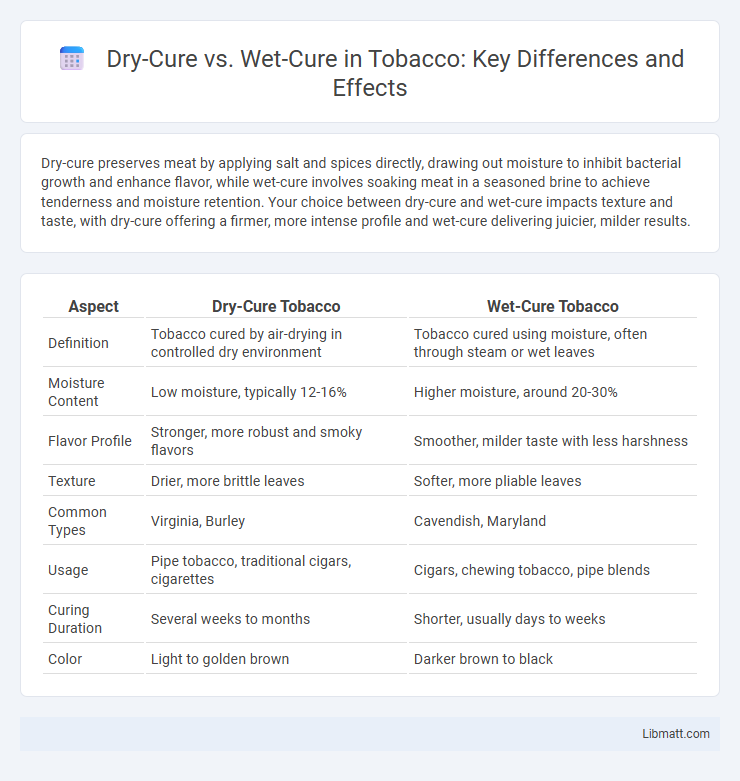Dry-cure preserves meat by applying salt and spices directly, drawing out moisture to inhibit bacterial growth and enhance flavor, while wet-cure involves soaking meat in a seasoned brine to achieve tenderness and moisture retention. Your choice between dry-cure and wet-cure impacts texture and taste, with dry-cure offering a firmer, more intense profile and wet-cure delivering juicier, milder results.
Table of Comparison
| Aspect | Dry-Cure Tobacco | Wet-Cure Tobacco |
|---|---|---|
| Definition | Tobacco cured by air-drying in controlled dry environment | Tobacco cured using moisture, often through steam or wet leaves |
| Moisture Content | Low moisture, typically 12-16% | Higher moisture, around 20-30% |
| Flavor Profile | Stronger, more robust and smoky flavors | Smoother, milder taste with less harshness |
| Texture | Drier, more brittle leaves | Softer, more pliable leaves |
| Common Types | Virginia, Burley | Cavendish, Maryland |
| Usage | Pipe tobacco, traditional cigars, cigarettes | Cigars, chewing tobacco, pipe blends |
| Curing Duration | Several weeks to months | Shorter, usually days to weeks |
| Color | Light to golden brown | Darker brown to black |
Introduction to Curing: Dry-Cure vs Wet-Cure
Dry-cure involves applying salt and seasonings directly onto the surface of meat, promoting moisture loss and intensifying flavors through slow dehydration. Wet-cure, also known as brining, submerges the meat in a saline solution infused with spices and sugar, resulting in a juicier texture by retaining moisture. Both methods enhance preservation and flavor development but differ in moisture control, curing time, and texture outcome.
What is Dry-Curing?
Dry-curing is a preservation method where meat is coated with a mixture of salt and spices, drawing out moisture through osmosis to inhibit bacterial growth. This technique enhances flavor and texture by allowing the meat to slowly age in a controlled environment with low humidity. Common examples include prosciutto and dry-cured salami, prized for their intense taste and firm consistency.
What is Wet-Curing?
Wet-curing is a meat preservation process that involves submerging the product in a brine solution, typically made of water, salt, sugar, and various spices, to enhance flavor and moisture retention. This method allows for a faster curing time compared to dry-curing, resulting in a juicier and more tender final product ideal for hams, bacon, and deli meats. Understanding wet-curing can help you choose the best technique for your desired texture and taste in cured meats.
Key Differences Between Dry-Cure and Wet-Cure
Dry-cure involves rubbing salt and sometimes spices directly onto the meat's surface, drawing out moisture to enhance flavor and texture, while wet-cure uses a brine solution to infuse the meat with salt and often sugar or other seasonings. Dry-cured products typically have a firmer texture and more concentrated flavor due to moisture loss, whereas wet-cured meats remain juicier and softer as they absorb the curing liquid. Understanding these key differences helps you select the best curing method based on your desired taste, texture, and preservation needs.
Flavor Profiles: How Methods Impact Taste
Dry-cure methods intensify flavor by drawing out moisture, resulting in a concentrated, robust taste with earthy and smoky notes. Wet-cure processes inject brine or marinade, imparting a juicier texture and a subtle, savory profile often enhanced by spices and herbs. Your choice between dry-cure and wet-cure influences the depth and complexity of flavor in cured meats, tailoring the taste experience to your preference.
Texture and Appearance: Comparing Results
Dry-cure methods produce meats with a firmer texture and a darker, more concentrated color due to moisture loss and salt absorption, enhancing the product's density and richness. Wet-cure techniques result in juicier meats with a lighter appearance and softer texture, as the brine infusion retains moisture and tenderness. The choice between dry-cure and wet-cure significantly impacts visual appeal and mouthfeel, with dry-curing favored for its traditional, robust characteristics and wet-curing preferred for its moist, delicate finish.
Health, Safety, and Shelf Life Considerations
Dry-cure methods reduce moisture content, inhibiting bacterial growth, which can enhance food safety and extend shelf life, making it healthier compared to wet-cure methods that involve soaking in brine and may retain more water and potential contaminants. Wet-cure processes can increase the risk of pathogenic bacteria if not properly controlled, requiring stricter sanitation to ensure consumer safety. Your choice between dry-cure and wet-cure impacts product preservation, with dry-cure generally offering longer shelf life and a safer, more stable final product.
Common Uses for Each Curing Method
Dry-cure methods are commonly used for products like cured hams, salami, and bacon, where intense flavor concentration and longer preservation are desired. Wet-cure techniques are preferred for items such as ham, corned beef, and turkey, offering faster curing times and improved moisture retention. Understanding these common uses helps optimize Your choice based on texture, flavor intensity, and processing efficiency.
Step-by-Step Guide: Dry-Cure vs Wet-Cure Process
Dry-cure involves rubbing meat with a salt-based mixture, allowing it to absorb flavors and draw out moisture over a controlled period, typically ranging from several days to weeks. Wet-cure, or brining, submerges meat in a seasoned liquid solution of water, salt, and curing agents, enabling rapid penetration and consistent moisture retention usually within hours to days. Understanding these processes helps optimize texture, flavor, and preservation based on desired culinary outcomes.
Which Curing Method Should You Choose?
Choosing between dry-cure and wet-cure methods depends on your desired flavor, texture, and preservation needs. Dry-cure enhances the meat's intensity and creates a firmer texture by drawing out moisture through a salt-based rub, while wet-cure, or brining, infuses moisture and tenderizes the meat by soaking it in a saltwater solution. Your selection should consider the curing time available and the final product's taste profile you want to achieve.
dry-cure vs wet-cure Infographic

 libmatt.com
libmatt.com